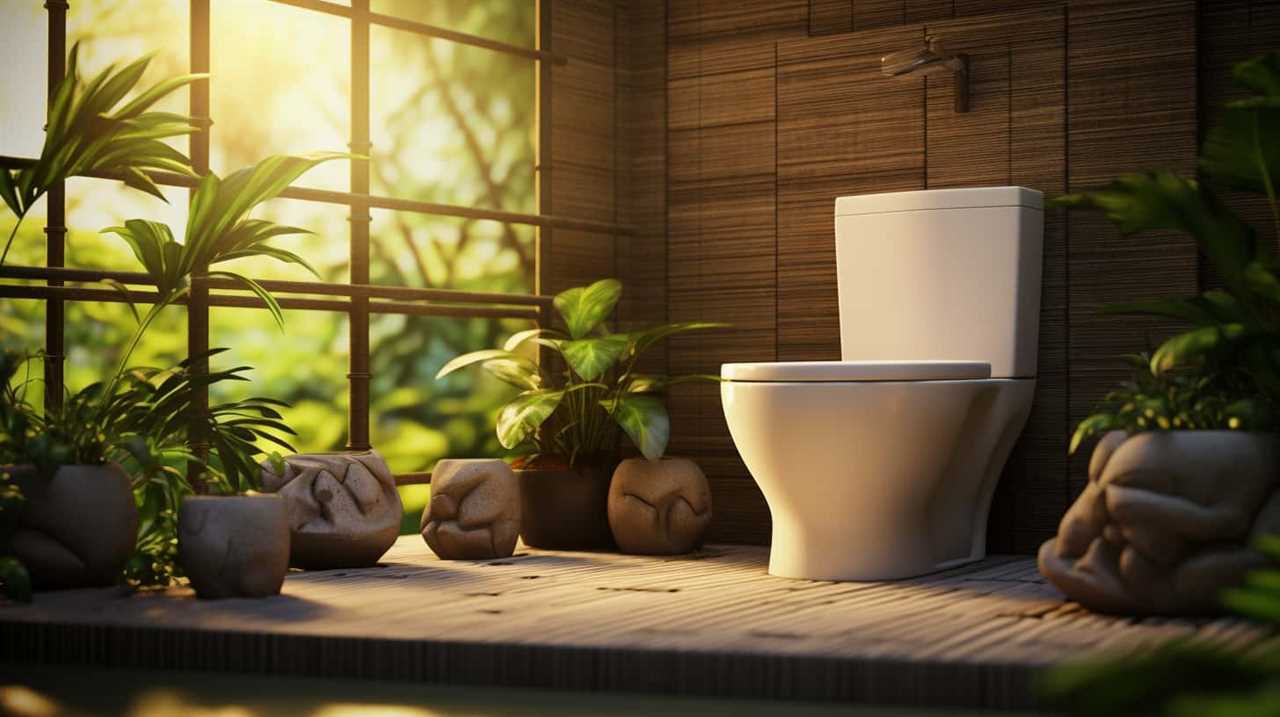The question that has intrigued many inquisitive minds is this: does the toilet truly flush in the opposite direction in Australia?
Prepare for a journey into the realm of physics and debunking common misconceptions. In this article, we shall unravel the truth behind the Coriolis Effect and its influence on toilet direction.
With an objective and analytical approach, we will explore the factors that determine the swirling motion.
Brace yourselves, for we are about to master the art of toilet flushing in the land down under.

Key Takeaways
- The Coriolis effect doesn’t influence the direction of toilet flushing.
- Toilet flushing direction is determined by the design of the toilet bowl and the angle at which the water enters.
- The belief that toilets flush the other way in Australia is a misconception.
- Understanding the factors that influence toilet flushing can lead to a more informed discussion.
The Coriolis Effect and Toilet Flushing
We’ve observed that the Coriolis effect doesn’t actually influence the direction of toilet flushing. Contrary to popular belief, the misconceptions surrounding the Coriolis effect and its impact on toilet flushing are largely unfounded.
Numerous toilet flushing experiments have been conducted to investigate this phenomenon, and the results consistently indicate that the direction of toilet flushing is determined by the design of the toilet bowl and the angle at which the water enters. The Coriolis effect, which refers to the apparent deflection of moving objects caused by the rotation of the Earth, is simply not strong enough to affect the swirling motion of water in a small-scale domestic toilet.
These findings highlight the importance of basing scientific understanding on empirical evidence rather than relying on misconceptions or popular myths.
Debunking the Southern Hemisphere Myth
In our investigation, we discovered that the belief about toilets flushing the other way in Australia due to the Coriolis effect is a myth. To further debunk this Southern Hemisphere myth, we conducted several myth-busting experiments and analyzed the results. Here are the key findings:

- Coriolis effect is too weak: The Coriolis effect, caused by the rotation of the Earth, isn’t strong enough to influence the direction of toilet flushing. Its impact is only noticeable in large-scale weather patterns.
- Toilet design matters: The shape and design of toilets, not the Coriolis effect, determine the direction of flushing. The orientation of the flush jets and the shape of the bowl play a significant role in determining the direction of the flush.
- Cultural differences: The belief about toilets flushing differently in the Southern Hemisphere may stem from cultural differences rather than scientific facts. It could be a case of cultural misunderstanding or miscommunication.
- Observational bias: Most anecdotal evidence supporting the myth comes from people’s personal observations, which can be biased and influenced by preconceived notions. Scientific and controlled experiments are necessary to determine the truth.
Understanding the Physics of Toilet Flushing
To understand the physics of toilet flushing, let’s explore how water flows through the plumbing system. When you press the flush button, water is released from the tank and flows into the bowl. This creates a siphoning effect, where the water is pulled down and out through the drain. The force of the water rushing down creates a vacuum that pulls waste and debris with it.
Over time, toilet design has evolved to optimize flushing efficiency. Modern toilets often feature larger trapways and improved bowl shapes to enhance the flow of water and prevent clogging. Additionally, cultural differences can influence toilet flushing habits. Some countries may prefer a higher water volume for a more forceful flush, while others prioritize water conservation and opt for lower volumes. Understanding the physics behind toilet flushing can help us appreciate the engineering advancements and cultural considerations that contribute to our everyday bathroom experiences.
| Toilet Design Evolution | Cultural Differences in Toilet Flushing | |
|---|---|---|
| 1 | Larger trapways | Higher water volume |
| 2 | Improved bowl shapes | Water conservation |
| 3 | Enhanced water flow | Flushing habits vary by country |
Exploring the Factors That Influence Toilet Direction
One factor that can influence the direction of toilet flushing is the Coriolis effect. The Coriolis effect is a result of the Earth’s rotation and causes moving objects, such as water in a toilet bowl, to be deflected to one side. However, it’s important to note that the Coriolis effect is very weak and isn’t the primary factor determining the direction of toilet flushing. Other factors, such as the influence of water pressure and cultural differences, play a more significant role.
Influence of water pressure: The force exerted by water entering the toilet bowl can affect the direction of flushing. Higher water pressure can create a stronger downward flow, leading to a different flushing direction.

Cultural differences: In some countries, the design of toilet bowls and plumbing systems may vary, leading to different flushing mechanisms. This can result in variations in the direction of toilet flushing across different cultures.
Plumbing system design: The design of the plumbing system, including the shape and size of the pipes, can influence the direction of toilet flushing. Variations in these factors can cause differences in the flushing direction.
Toilet bowl design: The shape and design of the toilet bowl itself can affect the direction of flushing. Factors such as the position and angle of the rim jets can impact the flow of water, leading to variations in the flushing direction.
Understanding these factors can help debunk the myth that toilet flushing always follows a specific direction based on location and emphasize the importance of considering multiple influences when studying toilet flushing.

The Truth About Toilet Flushing in Australia
Now let’s delve into the truth about toilet flushing in Australia and explore how different factors can influence the direction of toilet flushing in this country.
Toilet flushing can vary across different countries due to a combination of factors, including plumbing systems, design of the toilet bowl, and the direction of water flow.
Contrary to popular belief, the direction of toilet flushing in Australia isn’t determined by the country’s location in the Southern Hemisphere. Instead, it’s primarily influenced by the design of the plumbing system and the shape of the toilet bowl.
Cultural beliefs and superstitions about toilets may play a role in certain regions, but they don’t have a direct impact on the direction of toilet flushing.

It’s important to approach discussions about toilet flushing with an objective and analytical mindset, considering the technical aspects rather than relying on myths or misconceptions.
Frequently Asked Questions
Are There Any Other Factors Besides the Coriolis Effect That Can Influence the Direction of Toilet Flushing?
Factors affecting toilet flushing direction can include the design of the toilet bowl, water pressure, and the location of the drain. Additionally, the impact of local plumbing systems can play a role in determining the direction of the flush.
Is It Possible for the Toilet Flushing Direction to Change Within a Single Country Like Australia?
In different countries, the toilet flushing direction varies due to the impact of plumbing systems. It is possible for the direction to change within a country like Australia, depending on the design of the plumbing.
How Does the Shape and Design of the Toilet Bowl Affect the Direction of Flushing?
The shape and design of the toilet bowl have a significant impact on the direction of flushing. The relationship between toilet bowl shape and water flow determines whether the water will swirl clockwise or counterclockwise.

Can the Speed of Water Flow in the Toilet Affect the Direction of Flushing?
The water level in the toilet bowl and the temperature of the water can impact the direction of flushing. Understanding how these factors interact is crucial for achieving mastery in toilet mechanics.
Are There Any Other Misconceptions or Myths Related to Toilet Flushing Direction in Different Parts of the World?
There are various misconceptions about toilet flushing in different parts of the world. One popular myth is that the direction of flushing changes in Australia due to the Coriolis effect. However, the impact of water pressure determines the flushing direction, not the hemisphere.
Conclusion
In conclusion, the myth that toilets flush in the opposite direction in Australia due to the Coriolis effect has been debunked. The direction in which a toilet flushes is primarily determined by the design of the toilet and the angle of the jets.
The Coriolis effect has negligible influence on toilet flushing. So, rest assured, when it comes to toilets, Australia is just like any other place on Earth.

No need to fret over which way the water spins down the drain!










